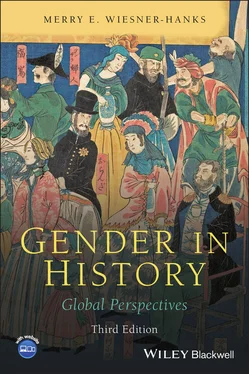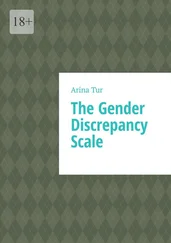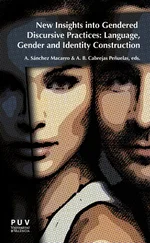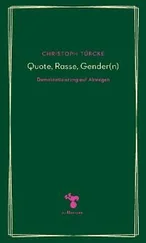Studies of women and gender are also very unevenly distributed geographically and chronologically. Books on women’s experience or that use gender as a category of analysis in the twentieth-century United States or early modern England, for example, number in the hundreds, while those that focus on Kiribati or Kazakhstan may be counted on one hand. This unevenness is related, not surprisingly, to uneven growth in women’s and gender studies programs, which is in turn related to the structure of higher education around the world and the ability or willingness of institutions of higher education to include new perspectives and programs. By the late 1970s, hundreds of colleges and universities in the United States and Canada offered courses in women’s history, and many had separate programs in women’s history or women’s studies. Universities in Britain, Australia, the Netherlands, and the Scandinavian countries added courses and programs a bit more slowly, and other developed countries were slower still, though by the 1990s courses in women’s history were introduced in India, China, Korea, and elsewhere, especially at women’s universities. In Japan and elsewhere, much of the research on women has been done by people outside the universities involved with local history societies or women’s groups, so has not been regarded as scholarly.
Scholars and students in some countries in the early twenty-first century still report that investigating the history of women, gender, or sexuality can get them pegged as less than serious and be detrimental to their future careers as historians. Added to this is backlash against women’s and LGBTQ+ rights, and sometimes to the entire concept of gender, in countries headed by authoritarian men who advocate traditional gender roles. Brazil’s President Jair Bolsonaro, for example, elected in 2018, has attacked what he terms “gender ideology,” by which he means policies aimed at improving gender equality and lessening homophobia. Hungary’s Prime Minister Viktor Orbán offered tax benefits and subsidies to women who had at least four children and banned gender studies from Hungarian universities. In 2020 the Hungarian Parliament voted to stop transgender and intersex people from legally changing their gender. Gender- and sexuality-based violence has increased in Brazil and Hungary, as well as in other countries with right-wing populists in charge.
The history done in any country, not simply Brazil and Hungary, is shaped by regional and world politics, and issues other than gender have often seemed more pressing to historians in Latin America, Eastern Europe, and other parts of the world where political and economic struggles have been intense. Universities and researchers in developing countries also have far fewer resources, which has hampered all historical research and limited opportunities for any new direction. Thus an inordinate amount of the work in the history of women, gender, and sexuality, including that which focuses on the continent of Europe and many other parts of the world, has been done by English-speaking historians, and the amount of research on English-speaking areas far outweighs that on the rest of the world. There is also imbalance within English-speaking areas, for studies of the United States vastly outnumber those of anywhere else.
There are signs that this imbalance is changing somewhat, as organizations to promote the history of women, gender and sexuality, and academic women’s/gender/sexuality studies programs are gradually being established in more countries, sometimes at great risk to those who organize them. Yet the head start of English-language scholarship, combined with the ability of many students and scholars throughout the world to read English – and the inability of many English-speaking students and scholars to read anything but English – have meant that the exchange of theoretical insights and research results has to this point been largely a one-way street.
The dominance of English-language scholarship is both a blessing and a curse for the purposes of this book. Because of the book’s intended audience of students as well as scholars, I decided to include only English-language materials in the suggestion for further reading that follow each chapter, and to make these brief. You can trust that these works contain much of the newest and best research available, and they point to materials in other languages, but they represent only a small fraction of what is there. To explore any topic fully, you will need to go far beyond them, and in many cases, as with any historical topic, to read source materials, analyses, and theoretical discussions in other languages as well.
Organizing a brief book on a subject this huge was a challenge, made even greater by the fact that a key theme in women’s and gender history has been the arbitrary and artificial nature of all boundaries – chronological, national, methodological, sexual. Thus for the first two editions of this book, I decided to organize the book topically rather than geographically or chronologically, in order to highlight the specific connections between gender and other structures and institutions. Each topical chapter investigated the ways in which what it meant to be male and female was shaped by such aspects of society as economic or religious structures, and also explored the reverse – how gender in turn shaped work, for example, or religious institutions.
For this third edition, I decided to reorganize the book completely, and, beginning with Chapter 3, present the material chronologically, with each chapter covering a shorter time frame than its predecessor. This decision was in part a response to comments from faculty who have used the book that a chronological organization would better meet their needs and those of their students. Each chapter incorporates material that was in the topical chapters, including discussion of the family, religion, politics, economic issues, culture, and sexuality, as well as new information based on the scholarship of the past decade. Each chapter discusses many of the world’s cultures, notes both distinctions among them and links between them, and suggests possible reasons for variations among cultures and among different social, ethnic, and racial groups within one culture.
Chapter 2is an update of what was Chapter 4in the previous editions, and looks at key ideas and ideals that emerged in a number of cultures and then shaped the informal norms and more formalized laws regulating every realm of life. This is not to say that these concepts were the same everywhere or that they did not change over time, but that there have been significant similarities, parallels, and continuities across time and space. These include: ideas about the nature and proper roles of men and women, what is often termed masculinity and femininity or manhood and womanhood; binaries related to male/female binaries, including nature/culture, public/private, inner/outer, order/disorder, rational/passionate; norms and laws regarding motherhood and fatherhood; ideas and laws prescribing male dominance and female subservience and dependence; ideas and laws promoting gender egalitarianism.
The chronological chapters begin with Chapter 3. Just as they have de-emphasized the nation as the most significant geographic unit, most global historians have also de-emphasized the invention of writing as a sharp dividing line in human history. With this the border between archaeology and history disappears, and the Paleolithic (2,000,000–9500 BCE) and Neolithic (9500 BCE–3000 BCE) become part of history rather than “prehistory.” Chapter 3covers these eras. It begins with the evolution of hominids, looks at Paleolithic society and culture, examines the impact of domestication and the development of agriculture in the Neolithic on gender roles and relationships, and ends with a discussion of debates over the origins of patriarchy.
Читать дальше












